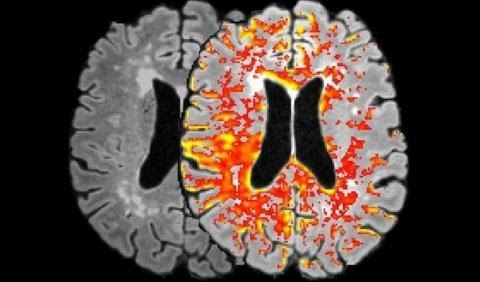Cognition and Dementia
Crossroad
Research Line: Neuroimaging
Clinical Pillar: Cognition and Dementia
We apply various advanced magnetic resonance imaging (MRI) techniques and data analysis methods to multiple populations, including patients with cognitive decline and neurodegenerative disorders (Alzheimer Centre Limburg) and the general population (The Maastricht Study). We aim to answer fundamental and clinically relevant neurological questions, and thus obtain a better understanding of the underlying mechanisms of dementia and its comorbidities.
Unique contributions and highlights
Blood-brain barrier (BBB) leakage in Alzheimer disease
The neuropathology of Alzheimer disease (AD) is characterized by amyloid plaques and neurofibrillary tau tangles, although evidence is increasing that impairment of the cerebral microvasculature is a contributing factor in the pathophysiology of AD. We developed several advanced cerebrovascular MRI techniques and demonstrated.
- that global blood-brain barrier (BBB) leakage in patients with early AD is associated with cognitive impairment (van de Haar, Radiology. 2016 Nov;281(2):527-535),
- that the neurovascular unit is impaired in early AD (van de Haar, Neurobiol Aging. 2016 Sep;45:190-196),
- that cerebral small vessel disease forms a link between BBB leakage and cognitive impairment in older individuals (Freeze, Neurobiol Aging. 2020 Jan;85:113-122).
Ultra-high field neuroimaging
We developed 7T methodologies to improve the in vivo investigation of the neuromodulatory nuclei (e.g. locus coeruleus) in the brainstem and subcortical regions to improve early detection of cognitive decline and neurodegenerative disorders. (Priovoulos, Neuroimage. 2018 Mar;168:427-436 & 2019 Nov 1;201:116071).
Cerebral networks and cognition
Affected brain connectivity likely underlies cognitive impairment. MRI can provide unique information on structural connectivity (i.e. the white-matter pathways in the brain) and functional connectivity (i.e. the temporal coactivations of the brain regions). In patients with mild cognitive impairment, we showed that effective temporoparietal connectivity is increased, while maintaining intact behavioral performance (Jacobs, Neurology. 2012 Jan 31;78(5):352-60). Recently, using the imaging data from The Maastricht Study we showed that functional (van Bussel, Diabetes. 2017 Feb;66(2):560) and structural (Vergoossen, Diabetes Care. 2020 Jan;43(1):201-208) networks of participants with type 2 diabetes and prediabetes are affected as well.

Magnetic resonance brain image of an Alzheimer’s patient with colour-coded blood-brain barrier leakage. (van de Haar, Radiology. 2016 Nov;281(2):527-535)


Staff involved in this crossroad
- Walter Backes
- Martin van Boxtel
- Linda Jacobi-Postma
- Heidi Jacobs
- Jaap Jansen
- Joost de Jong
- Inez Ramakers
- Miranda Schram
- Frans Verhey
- Joachim Wildberger